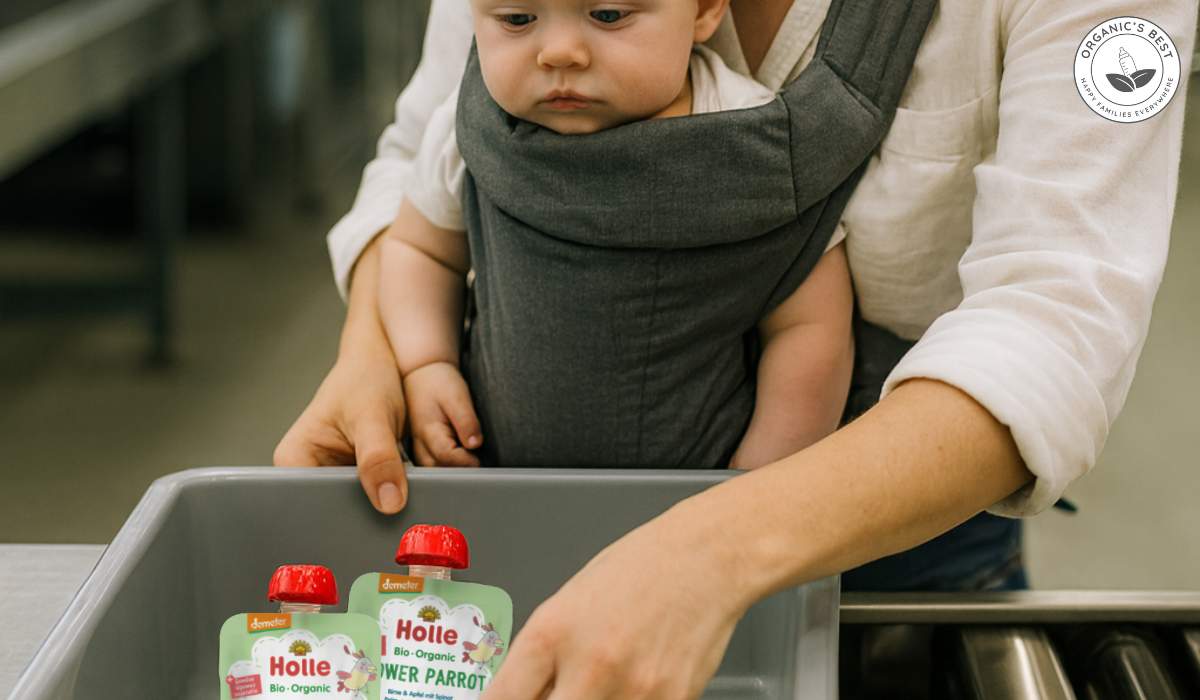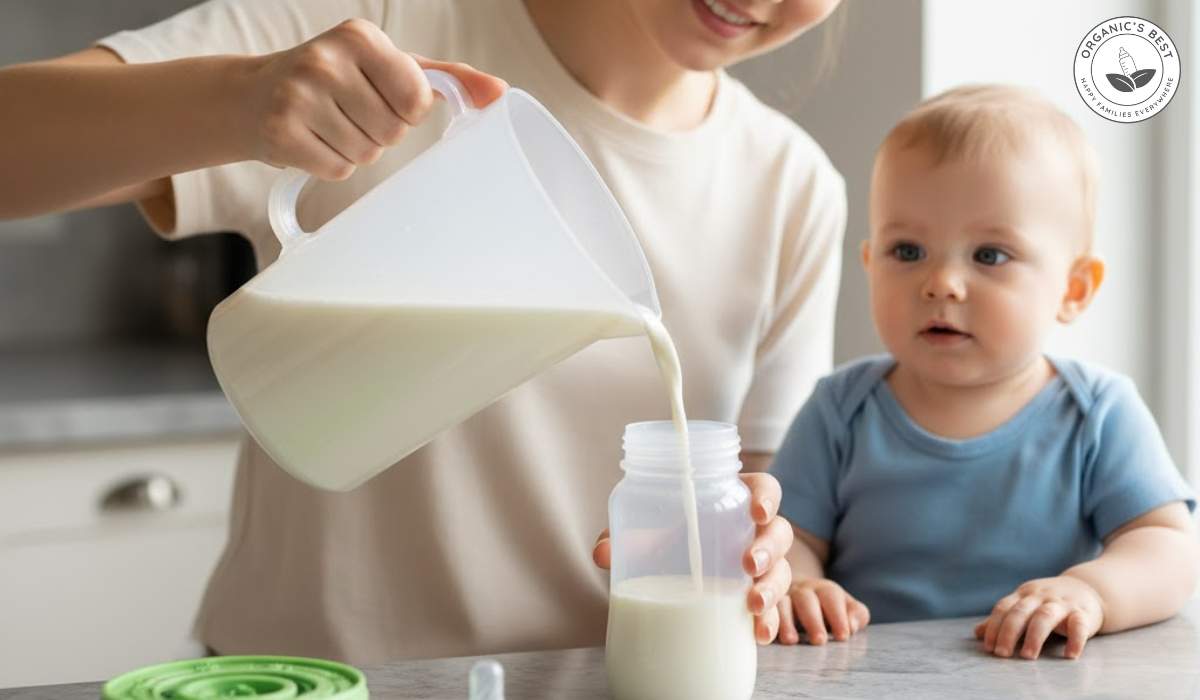Click to Get 2 FREE Boxes/Cans
Only New Customers! Click HERE to Get 2 Extra Boxes/Cans for Free With Your First Order.
BABY FORMULA
Offering new parents top-quality European infant formula from renowned brands like HiPP, Holle, Kendamil, and more. If you’re uncertain about which product to choose, our Formula Finder can help you make the best decision for your baby.
Baby Food
Offering new parents a premium selection of European baby foods, including jars, pouches, cereals, and snacks from esteemed brands like HiPP and Holle.
How to Embrace Comfort Nursing
by Agustina Fernandez September 05, 2023 9 min read

Many moms are already familiar with the benefits of breastfeeding on demand, but there's another valuable nursing practice that may surprise you: comfort nursing!
Comfort nursing, AKA non-nutritive sucking, non-nutritive breastfeeding, flutter sucking, or comfort feeding, is when a baby snuggles up to your breast for love, reassurance, and closeness, rather than only nursing for food. But don't be fooled, you are likely still going to release some breast milk and therefore transfer a little milk and calories to your baby from comfort sucking.
You may have heard that comfort nursing is used to soothe a fussy baby, but it's much more than that! It is a powerful bonding tool for moms and their little ones. Comfort nursing is totally natural and instinctual for babies, and it plays a crucial role in their development and overall well-being.
In this article, we're spilling the milk on everything you need to know about comfort nursing. From its definition to some practical tips for successful nursing sessions, we've got you covered! Whether you're a first-time mom or a seasoned pro, we want to equip you with all the knowledge and confidence to embrace this nurturing practice.
Table of contents
Discover the Power of Comfort Nursing: Benefits Explained
The bond between a mother and her baby is truly one of a kind, and comfort nursing is just one of the many practices that strengthen this beautiful connection. Let's talk about some of the psychological benefits here and exactly how non-nutritive sucking can help your baby to sleep and promote security and connection.

Promoting Serenity and Tranquility 🧘
Flutter-sucking works like a charm when it comes to bringing serenity and tranquility to your little one's world. Imagine the magic that happens when your baby snuggles up to your breast for comfort—it's like a warm, reassuring hug that washes away their worries and fussiness.
But here's how: comfort nursing triggers the release of a flood of soothing hormones. These little feel-good messengers make your baby feel safe, secure, and content, putting them in a state of pure bliss.
So, when your little munchkin is looking to comfort feed, let them nestle in your arms and experience that sweet serenity!
Nurturing the Bond 💗
Comfort nursing isn't just about feeding your baby; it's a nurturing experience that weaves an unbreakable bond. The physical, skin-to-skin contact during comfort sucking releases oxytocin, often referred to as the "love hormone," in both the mother and the baby.
Oxytocin promotes feelings of attachment, love, and trust, fostering a deep emotional connection between many mothers and babies. This can have a positive impact on the mother's mental health and well-being while providing the baby with a sense of security. Plus, it can help reduce your baby's stress hormones.
But the magic of flutter-sucking doesn't end there.
Comfort-sucking also plays a significant role in strengthening your breastfeeding relationship. When your baby experiences comfort and security during nursing sessions, they associate breastfeeding with love, warmth, and contentment. This positive association builds trust and encourages them to nurse more eagerly and effectively.
Offering Reassurance and Security 🛡️
In a big, wide world full of new experiences, your baby seeks comfort and security in your loving embrace. That's where comfort nursing comes in as their safe haven. When you comfort nurse, you respond to your baby's desire and need, showing them that you're always there to offer love and protection, in addition to a full meal.
Just like us, babies experience a range of emotions, and comfort nursing serves as a natural way to soothe and regulate those feelings. When a baby feels upset, anxious, or distressed, nursing provides them with a familiar source of comfort and emotional support, helping them feel secure and protected.
Research even suggests that breastfeeding babies can help with pain relief. In this study, after a heel-prick sampling, breastfeeding outperformed other interventions like being held, ingesting an oral glucose solution, and even using a local anesthetic to reduce a baby's pain. Talk about the incredible soothing powers of breastfeeding!
Comfort Nursing Can Help Breastfeeding Babies Fall Asleep 💤
Comfort nursing can work wonders when it comes to helping babies fall asleep. Comfort nursing can become a sleep association for babies, meaning they associate nursing with falling asleep. When they wake up during the night, the familiar act of nursing can help them quickly drift back to sleep.
It also seems frequent breastfeeding has a calming effect on babies' nervous systems, helping to regulate their sleep patterns and overall circadian rhythms. The soothing hormones released during nursing can aid in establishing a more predictable sleep-wake cycle.
Techniques for Successful Comfort Nursing
Whether you are new to this journey or just want some extra reassurance, this section will go through tips on how to comfort nurse successfully.
Let's go over some of the best tips and techniques for flutter-sucking!
Decoding Cues 🔎
It is important to learn to recognize the different cues your baby gives to indicate whether they are genuinely hungry or seeking comfort. By understanding their signals, you can respond appropriately to their needs.

These signs may indicate that your baby is hungry:
• Sucking on hand or fists
• Opens and closes mouth
• Turning their head toward your breast
• Appearing calm and wide-eyed after a nap
• Rooting with a strong, nutritive suck
• Continuous crying after comforting them with other methods
These signs may indicate that your baby is seeking comfort:
• Flutter sucking or making little sucks
• Slowing down or stopping to suck while feeding
• Looking into space while nursing
• Rooting and sucking lightly at the breast
• Arching and grabbing ears
Creating a Cozy Oasis ☮️
Comfort nursing can be enhanced by creating a comfortable and peaceful environment for both the mother and baby. Dim lighting, soft music, and a quiet space can help promote a calming atmosphere during nursing sessions.
Embracing the Perfect Positions 🤱
Finding the right nursing positions can significantly impact both the baby's and mother's comfort during a nursing session. Experimenting with different holds, such as the cradle hold, football hold, or side-lying position, can help determine the most comfortable option.
The Power of a Good Latch 👄
Ensuring a proper latch is essential for effective breastfeeding, whether it's simple for feeding or comfort. A correct latch helps prevent experiencing discomfort or pain for the mother and ensures the baby is getting enough milk.
During flutter sucking, your baby's latch may slightly loosen, and you might notice a significant change in the pace of their sucking compared to when they are feeding just for milk intake. They may also hold the breast with a lighter touch.
Tender Skin-to-Skin Moments 🤝
Skin-to-skin contact between the mother and baby has numerous health benefits, including enhancing bonding, regulating your baby's body temperature, and even stabilizing your baby's heart rate and breathing. Breastfeeding involves spending quality time with your baby skin-to-skin, which can also be done during comfort nursing sessions.
By incorporating these techniques into comfort nursing practices, parents can foster a stronger bond with their baby and provide additional emotional support and comfort during their early developmental stages. Remember that every baby is unique, so it's essential to be responsive to your baby's individual needs and cues.
How to Gradually Wean from Comfort Nursing
Comfort nursing can be a cherished bonding experience between a mother and her baby, but that doesn't mean it can last forever. There may come a time when gradual weaning becomes necessary or desired. Here are some steps to help you with the process:

Introducing Alternative Soothing Methods
As you begin the weaning process, it's essential to offer alternative soothing methods to your baby.
This can include the following:
• Using a pacifier
• Gently rub or stroke the baby's back, chest or tummy
• Gentle rocking
• Sing or talk to the baby in a soothing voice
• Swaddling
These alternatives can help your baby transition away from relying solely on comfort nursing for soothing and security.
Implementing Gradual Weaning Techniques
Gradual weaning is generally recommended for comfort nursing to minimize discomfort for both the baby and the mother. You can start by reducing the frequency and duration of comfort nursing sessions slowly.
You can gradually replace these nursing sessions with the alternative soothing methods mentioned above. Remember to give your baby time to adjust to the changes in their breastfeeding routine, and be patient throughout the process.
Seeking Support from Lactation Consultants or Breastfeeding Support Groups
Weaning can be an emotional and challenging journey for both the mother and the baby. Seeking guidance from lactation consultants or joining breastfeeding support groups can provide valuable advice, encouragement, and reassurance during this transition.
Breastfed babies and mothers will have their own unique experiences with flutter-sucking and weaning. Trust your instincts as a parent, and be attuned to your baby's needs and responses throughout the process. Gradual weaning can be a slow and loving process that nurtures the bond between both you and your little one as you navigate this new nursing relationship together.
Addressing Common Concerns and FAQs
We know that your little one's well-being is your top priority, which is why we want to address some of the most common concerns associated with comfort nursing.
The Difference Between Comfort Nursing and Cluster Feeding
Comfort nursing and cluster feeding are two distinct behaviours exhibited by babies during breastfeeding sessions.

Comfort Nursing: Comfort nursing is when a baby nurses primarily for comfort, soothing, and emotional closeness rather than for hunger or nourishment. During comfort nursing, a baby latches onto the breast but might not suck vigorously as it's not active feeding.
Instead, comfort breastfeeding is to seek comfort, security, and the calming presence of their mother. Comfort nursing often occurs outside regular feeding schedules and can happen at any time of the day or night.
Cluster Feeding: Cluster feeding involves frequent and closely spaced feeding sessions within a short period, often during certain times of the day. Cluster feeding is usually associated with periods of rapid growth, developmental milestones, or preparing for longer sleep stretches during the night. Cluster feeding can involve active feeding, wherein babies are consuming more milk than usual to meet their increased caloric needs.
Growth Spurts And Breast Milk Supply
Comfort nursing can be more prevalent during growth spurt spurts because babies may seek extra comfort and security as they experience increased physical and developmental changes.
This makes sense because, as your baby grows more rapidly, they will often exhibit more fussiness and a higher demand for breastfeeding and comfort nursing provides emotional support during these times. In some cases, comfort nursing can also trigger greater milk production in mothers.
So don't be alarmed if this habit becomes more prominent during times when your baby's caloric needs increase or if you notice a boost in your milk supply.
Dealing With Public Opinions and Misconceptions About Comfort Nursing
Comfort nursing can sometimes be misunderstood or met with skepticism from others who may not be familiar with its benefits. Here are some common misconceptions and the truth behind each assumption:
Comfort nursing means the baby is not getting enough milk:
One of the most prevalent misconceptions is that if a baby is comfort nursing, it indicates insufficient milk supply or inadequate feeding. In reality, comfort feeding or nursing is separate from regular feeding and serves a different purpose in providing emotional support and bonding.
However, if your baby often nurses but rarely seems content post-feeding or isn't gaining weight sufficiently, this may indicate they aren't receiving enough milk. If this situation feels familiar, a lactation consultant can help identify and resolve the issue. Prioritizing your little one's health is key – so don't hesitate to seek assistance when needed.
Comfort nursing creates spoiled or clingy babies:
There is a belief that allowing comfort nursing will lead to spoiled or overly dependent babies. In truth, comfort nursing is not a bad habit, it provides a safe and nurturing environment for babies to develop secure attachments to their caregivers, which is a healthy aspect of emotional development.
Comfort nursing hinders sleep training:
There's a misconception that comfort nursing interferes with sleep training efforts. While it's true that sleep training involves teaching babies to self-soothe, comfort nursing itself doesn't prevent successful sleep training when the time is right for both the baby and the caregivers.
Conclusion
Comfort nursing is a beautiful and natural part of the breastfeeding journey that goes beyond mere nourishment. It is a powerful tool for emotional bonding, providing babies with a sense of security, warmth, and reassurance.
Comfort nursing offers a profound opportunity for parents to cherish precious moments and create lasting memories with their little ones, contributing to the foundation of a loving and healthy parent-child relationship.
If you ever have any concerns about your breast milk or need help along your breastfeeding journey, we recommend seeking support from a qualified healthcare professional.
Disclaimer:
Please be aware that this information is based on general trends in babies and mothers, and it is not medical advice. Your doctor should be your first source of information and advice when considering any changes to your child’s formula and when choosing your child’s formula. Always consult your pediatrician before making any decisions about your child’s diet or if you notice any changes in your child. Breastfeeding is the best nutrition for your baby because breast milk provides your child with all the essential nutrients they need for growth and development. Please consult your pediatrician if your child requires supplemental feeding. |
Agustina Fernandez
Dr. Agustina Fernandez earned her medical degree from the prestigious Universidad Nacional de Córdoba, Argentina. With a deep-rooted passion for pediatrics, Dr. Fernandez is currently on the path to specializing in children's healthcare. Recently, she has delved into the vital field of infant nutrition. Her research interests include breastfeeding, infant formula, and baby food in little ones’ formative years. Dr. Fernandez's commitment to this area of study underscores her dedication to ensuring the health and well-being of children from their earliest days.
Leave a comment
Comments will be approved before showing up.
Also in Organic Infant Nutrition and Health Blog

Everything You Need To Know About Winter Pregnancy: Essential Tips for Moms-to-be
by Agustina Fernandez December 16, 2025 8 min read
Read More
Can You Bring Baby Food Pouches on a Plane? Essential Tips for Parents
by Agustina Fernandez December 09, 2025 7 min read
Read More
The Formula Pitcher: Is It Safe To Make A Whole Pitcher Of Baby Formula?
by Agustina Fernandez December 02, 2025 8 min read
Read More
Reviewed by Dr. Bardha Citaku, MD
-

Dr. Bardha Citaku: Medical Reviewer of Organic's Best Blog
Dr. Bardha Citaku completed her medical studies at the University of Prishtina in Kosovo, where she began her journey into the field of medicine. She has since developed a career in medical research, contributing to projects with notable organizations, including the World Health Organization (WHO).
